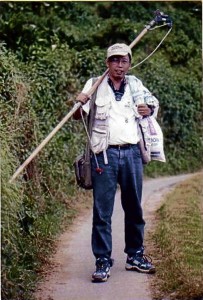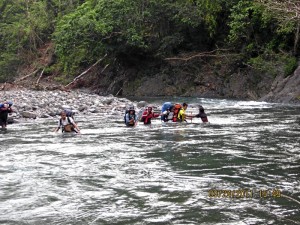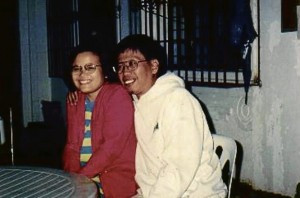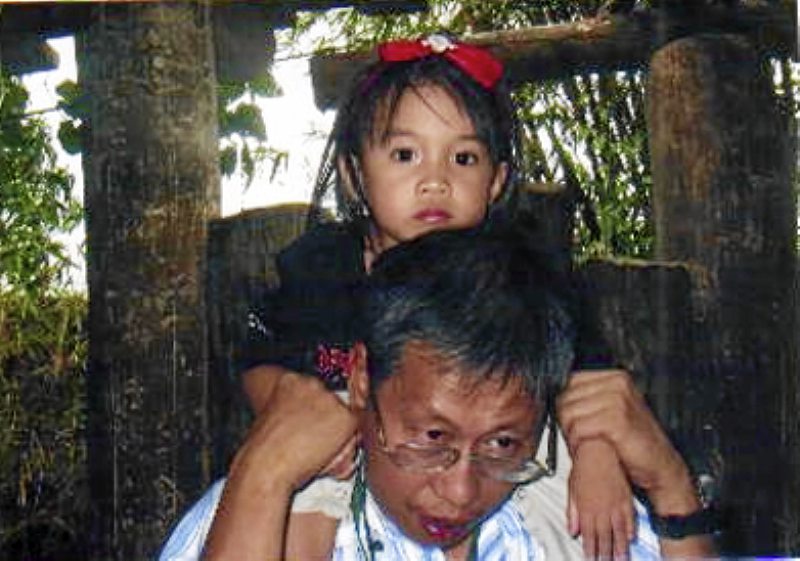HE knew the wilderness and its many secrets. Each leaf, each stem, each trunk spoke to him in ways ordinary humans might not hear. He hearkened to them and gave them names. From under the huge canopy of green that was his second home, he would emerge, carrying with him evidence of rare and amazing life. He had glimpsed paradise. The world, he thought, needed to know about the treasures hidden in these endangered vastness.

But Filipino botanist Leonardo L. Co was gone before he could share this bounty. Killed by military forces in the wilds of Kananga, Southern Leyte on Nov. 15, 2010, he left a void crying out to be filled. Who will follow in his footsteps in forests primeval?
But his family, friends and colleagues are not frozen in mourning. If they cannot totally fill Leonard’s mountain shoes, they are at least attempting to take the path less-traveled that the botanist had trod for many years. They, too, are heeding the call of the wild, embracing a world that the consummate scientist and lover of plants had considered as the place to be.
That was how it was in the days that ran up to Easter and Earth Day this year. To celebrate the botanist’s life, a Leonardo Co Trail was opened somewhere in the Sierra Madre mountain range bordering Palanan, Isabela. Going to Palanan alone takes some guts, as it is on the remote “other side” of Luzon, separated by awesome mountains and the so-called Last Great Forest.
Weeks before, an advance reconnaissance team (see photo) composed of University of the Philippines (UP) Mountaineers and their Dumagat guides prepared the way for the “Palanan Co Sierra Madre Trek” that was to follow during Holy Week, starting April 15.
Here’s a recon team member’s message sent by satellite phone: “5 days of trekking, 4 soaking wet nights, 30 mins of sunshine, 15 squares of canned sardines, 2 river eels, 7 leech bites, 3 foot blisters, more than a dozen river cross, countless slips and slides, and to top it all off, 4 very awesome Dumagats and 6 funny mountaineer friends, makes for 1 great and unforgettable experience, all for 1 very special botanist. And the best part is, we’re only halfway there.”
That was where this “1 very special botanist” had wished some of his ashes would be strewn. By now, Leonard’s wishes will have been fulfilled. His resting place: his “field lab,” the 16-hectare Forest Dynamics Plot in Palanan, begun in 1994 and of which Leonard was co-investigator (with Drs. Perry Ong and Daniel Lagunzad). In this area, some 335 species of plants have been identified. A trail was opened and named after him. (The other existing trails are the Aguinaldo, Carabao and Bisag Trails.) Some 30 mountaineers, friends and family members braved the wilds to honor him. Darwin Flores was trek organizer while veteran explorer-mountaineer and artist-teacher Bobby Acosta was trek leader. ROX Outdoor Gear was the main sponsor.

A third of Leonard’s ashes is with his family, the other third has been spread around his favorite Dita tree in UP. Said Glenda, his wife of 20 years, “He had chosen that tree and even brought our daughter Linnaea to see it.”
It takes a special woman to be a wife to Leonard whose romance with plants is not a secret. Leonard named his only child, now nine, after a plant that flowers in the North Pole and after Swedish botanist Carl Linnaeus, father of modern taxonomy.
Leonard so loved what he was doing that he did not think much about looks or how he projected himself. He was the stereotypical nerd, agreed his wife, a very dedicated and engaging teacher. There is one photo that always makes Glenda laugh. It shows Leonard lecturing in class with his fly open. It was said that he would get so carried away and wax poetic, students in front had to put up with saliva spray.

Leonard was a serious ethno-botanist and plant taxonomist who spent much time in the wilds. Pharmacology, a science that draws much from botany, was one of his fields of interest and expertise. He was also a trained acupuncturist. He knew several languages – Latin, French and German – besides his everyday Filipino, English and Chinese. An advocate of indigenous health practices, he worked with folk healers, shamans and mumbakis. Among his written works was “Common Medicinal Plants of the Cordillera Administrative Region,” an invaluable reference for upland community-based health workers. He also authored “The Forest Trees of Palanan, Philippines: A Study in Population Ecology.”
Many international and local environmental groups recognized and availed themselves of Leonard’s expertise. Among them was Conservation International, for which he worked as a consultant in the monitoring of biodiversity in several Philippine forests. He also supported environmental and health NGOs and participated in the government’s conservation efforts.
As a photographer, Leonard had a special eye for plants and other wildlife. Brother-in-law Darwin Flores said he went over never-before-seen shots in the memory card of Leonard’s camera and noticed images that didn’t seem to mean anything. There seemed to be only dry brown leaves and twigs, but upon closer scrutiny, one saw a small brown frog in camouflage. An insect, a snake, a bird disguised as twigs, leaves, and flowers.
But it was while identifying, naming and photographing rare native plants that Leonard was truly in his element. And oh, how he loved ferns. Not so much orchids, he could have told you. He lamented the disappearance of a rare endemic fern discovered for the first time by noted botanist Hermes Gutierrez (father of actress Chin-chin). Ever in search of rare species, Leonard scoured the forest floor and canopy, forged rivers and climbed mountains, carrying the ubiquitous cutting pole used for reaching plants in high places. He would be away for long stretches, six months sometimes, before he’d head for home. But he sure was blessed with many eureka moments up there.

A UP Mountaineer, Leonard was always behind the pack during treks because he picked plants along the way. He was recently given the posthumous UP Mountaineer of the Year Award.
Leonard considered his mountain forays as the convergence of science and outdoor adventure. It was not all about conquering the mountain peak or going from A to B. For him it was about the journey. He would say, “Ang tuktok ng bundok, bonus na lang yun.” (Reaching the top is just a bonus.)
Leonard’s death shocked the academe, the scientific community, environmentalists and health advocates. When Leonard, 56, was felled by bullets, along with his two guides Sofronio Cortez and Julius Borromeo, he was doing research for a reforestation project and was, witnesses attested, within the supposedly safe perimeter of the Energy Development Corporation research area, where armed groups weren’t supposed to be. Leonard took four bullets in the back and in the leg. Two other companions survived to tell the story. Initial reports said Leonard’s group was caught in the crossfire between the military and the communist rebels. But, as it turned out, there was no encounter. Even the local police said there was none. A case against the military is now pending.
Leonard left behind much work in progress and dreams for this planet. Many have vowed to continue what he had begun, like the Philippine Native Plants Conservation Society Inc. (PNPCSI) which Leonard founded in 2007. New PNPCSI president Anthony Arbias is making sure that the PNPCSI would be Leonard’s enduring legacy. It was their love for ferns that brought these two men together. Leonard also liked to study grass, Arbias recounted, and sometimes during trips he would yell, “Para!” (Stop!) just to get his hands on “rare grass ng Pilipinas.” One of Leonard’s regular companions was forester and UP bio-researcher Boni Pasion, whom he mentored. Pasion spent three months with Leonard in Palanan before the Leyte project where Leonard was killed.
PNPCSI has been given space at the Ninoy Aquino Wildlife Park in Quezon City. It’s an x-deal, Arbias said, for inventory work on plants in the 22-hectare compound which Leonard accepted with the ulterior motive of establishing an honest-to-goodness botanical park there. “A template for the regions,” Arbias stressed.
“Leonard was very much against the selling of areas of vegetation and turning them into real estate,” Arbias said. He was also against the use of exotic species for monoculture reforestation, like the use of mahogany, an exotic South American tree that was slowly replacing narra, the Philippines’ national tree. Leonard sarcastically called mahogany the “bagong pambansang puno” (the new national tree).
Born on Dec. 29, 1953 in Manila, Leonard was the eldest and only boy in the brood of Lian Sing Co and Emelina Legaspi. His father was a first-generation immigrant from China. Leonard went to the Philippine Chinese High School and excelled in science. He entered UP in 1972 but finished his botany degree only in 2008 because, his wife Glenda explained, “he forgot Physics.” Not having a diploma for a long time did not deter him from acquiring more knowledge and sharing them with young budding scientists.
In her article “Leonard Co: Bringing Knowledge of the Forests to the People” (Feedback, publication of Center for Environmental Concerns, Sept.-Dec. 2010) Lisa Ito-Tapang wrote: “Yet this delay in attaining complete academic credentials never deterred him from becoming one of the major experts in this field.” From 1977 to 2009, she wrote, Leonard co-authored six books and 13 articles in peer-reviewed publications, including researches on the Rafflesia aurantia (Rafflesiaceae), vaccimium (Ericeae), Xanthostemon fruticosus (Myrtaceaea) and Philippine ferns.
Leonard’s colleagues named two species – mycaranthes leonardi and rafflesia leonardi –after him. Not that he wished for this. He was credited with discovering eight new species of plants, and named one of them after business tycoon Oscar Lopez, who was said to be delighted.
Despite the serious nature of his work, Leonard knew how to relax in the company of like-minded friends. One of their favorite hang-outs was Green Daisy in Diliman, a small private garden hideaway under a bower of vines and branches. (It is owned by organic farming practitioner and entrepreneur Daisy Langenegger.) Leonard loved to show his culinary skills by cooking Chinese dishes for friends. A TV series he loved watching with his kid was GMA-7’s “Bantatay,” which was about a dog into whom the spirit of a slain veterinarian entered so he could protect his bereaved family.
“I would like to come back as a butterfly,” he would tell Linnaea. Indeed, wife Glenda said, there was a hovering butterfly after his death, prompting Linnaea to ask, “Nasaktan kaya siya?” (Did he feel pain?)
In his Facebook page Leonard lists as among his interests Bahay Tsinoy Museum (Kaisa), Philippine Tropical Forest Conservation Foundation, International Year of Biodiversity 2010, Philippine Native Plants Conservation Society and Marikina Watershed Initiative. His FB photo shows him sorting out leaves, captioned “Botany work by candlelight in our field camp on Mt. Cetaceo, the highest point in the Cagayan segment of the Sierra Madre Mtns.”
A lot has been said and written about Leonardo L. Co, botanist, and the immeasurable loss. PNPCSI’s statement could barely sum up the treasure that he was: “Few can realize the herculean task that Leonard Co set out to undertake. He spent a lifetime exploring and gathering precious data on the rapidly diminishing forested regions of the country. No one understood our native forest dynamics the way that he did. He provided a glimpse into its hidden order and where one would see just endless green, he would expound on the complex interrelationships between one living thing and another. He possessed first-hand knowledge that can never be found in any literature.”
His brother-in-law Darwin Flores offers some consolation: “Even in his last hours, he was in paradise.” •













































